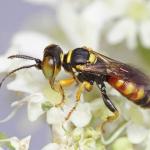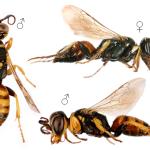Spex guttatus (Fabricius,1793) preocc.
This species is almost certainly extinct in mainland Britain, with most records from more than 100 years ago. It is placed within its own sub-family, Dinetinae, it being the sole species of this genus in Europe.
Old records come from observations noted by F. Smith prior to 1880 around Windsor and Ascot in Berkshire (Falk, 1991). A more recent record is from Oxshott Heath, Surrey, in 1950 (Baker in Baldock, 2010); unfortunately, the specimen was exchanged with a Japanese collector and is no longer available for inspection. There are modern records from Jersey on the Channel Islands.
Abroad, records are spread across much of Europe, although it is considered by Lomholdt (1984) to be a Mediterranean species with an emphasis, therefore, very much on southern European countries.
Both Shirt (1987) and Falk (1991) list this species in the Appendix (Extinct), although they were seemingly unaware of the Oxshott record. The Channel Islands are, for a number of reasons, excluded from the geographical coverage of the British Red Data book (Shirt, 1987) and the subsequent review (Falk, 1991).
No precise data for British specimens available, although Falk (1991) speculates with good reason, that hot, sunny heathlands are likely to have been favoured.
Unknown for British specimens. Dollfuss (1991) states June until September for central and northern Europe, although this may differ in more southern countries, more suited to its thermophilic lifestyle.
The genus Dinetus as a whole preys on Hemiptera, with Richards (1980) suggesting a preference for species in the family Reduviidae, with Lygaeidae also taken. However, Lomholdt (1984) suggests that Dinetus pictus takes species within the family Nabidae (Nabis ferus (Linnaeus) and Himacerus (as Aptus) myrmecoides (Costa)). This is repeated by Bitsch et al. (2001), who note that mainly nymphs are taken.
On the continent, nests are constructed in dry, sandy ground. No information is available about the Berkshire localities. Minkiewicz (1934) described the nesting tunnel as a short (6–7cm) gallery on a slight incline, which then turns almost vertically downwards, terminating in a single cell. Bitsch et al. (2001) cite other reports of several cells being excavated within the tunnel.
No information is available for Britain. Bitsch et al. (2001) state that the flowers visited are mainly from the Apiaceae (umbellifers), but then lists four genera, two of which (Achillea and Solidago) are within the Asteraceae (daisy family). They also mention Mentha rotundifolia (Lamiaceae) and Euphorbia nicaeensis (Euphorbiaceae), so its tastes may be fairly broad.
No information is available for Britain. Coulon (1925) reported the anthomyiid fly Leucophora cinerea Robineau-Desvoidy (as Anthomya albescens Zetterstedt) as a parasite.
2018



